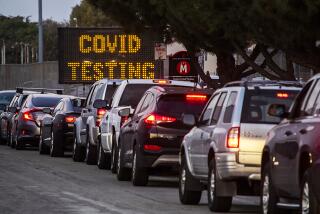U.S. Urged to Abandon AIDS Survey Plan : Health: Federal officials cite problems in Dallas and Pittsburgh pilot studies. They also point out that the project would cost $30 million.
- Share via
WASHINGTON — Federal health officials recommended Thursday that the government abandon plans to conduct a nationwide survey to determine the extent of AIDS infection in the United States.
Health officials currently estimate that between 1 million and 1.5 million Americans are infected with the human immunodeficiency virus. The goal of the nationwide survey, first proposed by the Ronald Reagan Administration in 1987, would be to obtain a more accurate projection.
But, after pilot studies were conducted in Pittsburgh and Dallas, health officials concluded that collecting blood samples and soliciting survey responses from a national sampling of American households would be too difficult and expensive to undertake.
“It just didn’t work,” said one official at the federal Centers for Disease Control, which recommended against the survey in its Morbidity and Mortality Weekly Report.
The CDC officials said that one of the biggest problems is that the same people who are considered at greatest risk for HIV infection also are the most likely to refuse to participate.
In the Dallas pilot study, for example, survey takers went back to many of those who initially refused to take part and offered them another opportunity to participate, either by giving a blood sample or by answering a questionnaire on risk behaviors.
“In the follow-up study, a larger proportion of participants reported intravenous drug use and male-to-male sex than those who consented to participate when first contacted,” the CDC said, noting that there was no effective way to adjust for this “non-response bias.”
Another problem, the CDC officials said, is that a national survey would cost at least $30 million.
The CDC officials said that the Dallas test, which was considered a “dry run” for a national survey, resulted in estimated rates of HIV infection that were “incompatibly low” in light of the known number of AIDS cases in the area.
Their conclusion was based on a comparison of the pilot study results and a method known as “back calculation,” which looks at the number of new AIDS cases each year and calculates backward to determine how many infected persons would have accounted for those cases.
Finally, the CDC said, a nationwide survey would require a great deal of advance work to prepare targeted communities and enlist the support of local groups.
In 1988, for example, when Washington, D.C., was scheduled to be one of the test study sites, city health officials complained that the federal government failed to consult with them.
They expressed fears that the study would be an invasion of privacy and that test results might not be kept confidential. Concerns were cited that Washington’s largely black community would be used as a guinea pig and stigmatized by the survey. As a result, federal health officials dropped Washington as a test site.
In Dallas, “they had extensive advisory groups to review everything, and they did an admirable job,” one federal health official said. “But they couldn’t do it in 50 different places in the country.”
The idea of conducting a national household survey was first proposed by former President Reagan in a major AIDS address on May 31, 1987, at the start of the annual international AIDS meeting, which took place that year in Washington.
Later that week, Dr. Otis R. Bowen, Reagan’s secretary of health and human services, proposed that blood samples be taken from about 45,000 randomly selected people. But federal health officials predicted at the time that many people would be reluctant to participate.
More to Read
Sign up for Essential California
The most important California stories and recommendations in your inbox every morning.
You may occasionally receive promotional content from the Los Angeles Times.













